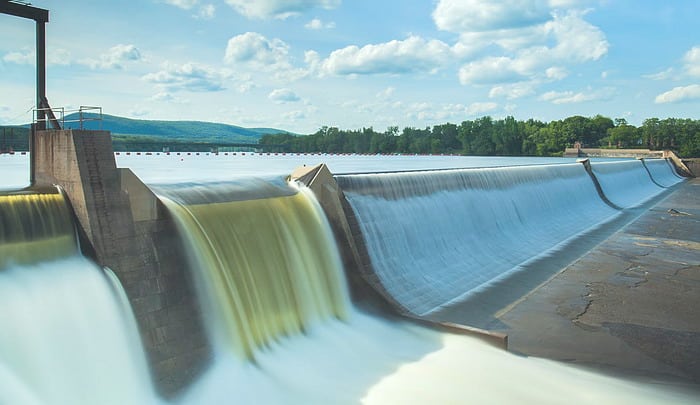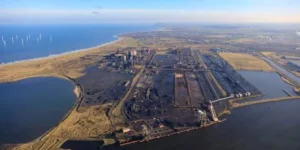How Do Hydro Power Plants Work?

Hydropower, also known as hydroelectric power, is a clean and sustainable source of energy that harnesses the force of moving water to generate electricity. In this article, we will explore the fascinating world of hydro power plants, understand their inner workings, and delve into the science that drives them. Let’s see how do hydro power plants work.
1. The Power of Moving Water
Hydropower is rooted in the fundamental principle of converting the kinetic energy of flowing water into electrical energy. It relies on the constant movement of water bodies like rivers, streams, and dams.
2. The Dam and Reservoir
Many hydro power plants are built near dams. These structures create artificial reservoirs, collecting water from upstream sources. The stored water in the reservoir serves as potential energy.
3. Controlling the Flow
The controlled release of water from the reservoir through the dam’s turbines is the key to generating electricity. By varying the flow, the power plant can adjust its electricity output to meet demand.
4. Turbines in Action
As the high-velocity water flows through the dam’s turbines, it sets them in motion. These turbines are connected to generators, which convert the mechanical energy into electrical energy.
5. Generator Operation
Generators at hydro power plants consist of coils of wire that rotate within a magnetic field. As the turbines spin the generator’s rotor, it induces an electric current in the wire coils.
6. AC and DC Conversion
The electricity generated is typically in the form of alternating current (AC). It is then converted into direct current (DC) for transmission to the grid and eventual distribution to homes and businesses.
7. Types of Hydropower
There are several types of hydropower plants, including run-of-river plants, storage plants, and pumped-storage plants. Each type has its unique characteristics and advantages.
8. Run-of-River Hydropower
Run-of-river plants do not require a reservoir; they generate electricity from the natural flow of the river. While they have a lower environmental impact, their electricity output may be less consistent.
9. Storage Hydropower
Storage hydropower plants, with their reservoirs, provide more control over electricity generation and can store energy for later use.
10. Pumped-Storage Hydropower
Pumped-storage plants are a form of grid energy storage. They use excess electricity to pump water to a higher reservoir during times of low demand. This water is then released to generate electricity during high-demand periods.

Hydroelectric power plant in China, image source: Unsplash
11. Environmental Impact
Hydropower is known for its minimal greenhouse gas emissions and small environmental footprint. However, the construction of large dams can have significant ecological consequences, affecting local ecosystems and communities.
12. A Worldwide Energy Source
Hydropower is one of the most widely used renewable energy sources across the globe. Countries like China, Brazil, and the United States are among the top producers of hydroelectricity.
13. Historical Significance
The concept of hydropower dates back to ancient times, with water wheels being used for tasks like grinding grain. The industrial revolution saw the development of water-powered mills, marking the early days of hydroelectricity.
14. Modern Advancements
Modern hydropower plants integrate advanced technologies to maximize efficiency, enhance safety, and minimize environmental impacts.
15. Grid Stabilization
Hydropower plays a crucial role in grid stabilization. It provides consistent, baseload power, helping to balance fluctuations from intermittent energy sources like wind and solar.
16. Future Innovations
Researchers continue to explore innovations in hydropower, such as small-scale and low-impact projects, to expand its potential and make it more environmentally friendly.
17. Hydropower in Remote Regions
Hydropower is often harnessed in remote or off-grid areas, providing sustainable electricity to communities that are far from conventional power sources.
18. Low Operating Costs
Once a hydropower plant is constructed, its operating costs are relatively low, making it an economically attractive and sustainable energy option in the long run.
19. Flood Control
Many dams constructed for hydropower generation serve dual purposes, including flood control. They can mitigate the impact of flooding by regulating the flow of water.
20. Recreation and Tourism
Reservoirs created by dammed rivers often become popular recreational areas, offering boating, fishing, and other leisure activities. This contributes to local tourism and economic development.

Run-of-river hydroelectric power plant in Thailand, image source: Unsplash
21. River Ecology Considerations
The environmental impact of hydropower can be complex, and careful planning is essential to protect river ecosystems, particularly migratory fish populations.
22. Ocean Energy
Hydropower is not limited to rivers and dams. Ocean energy, including wave and tidal energy, is another form of hydropower, harnessing the kinetic energy of ocean tides and waves to generate electricity.
23. International Collaboration
Countries worldwide collaborate on hydropower projects, sharing knowledge and expertise to optimize energy generation while minimizing environmental effects.
24. Future Challenges
One of the challenges in the hydropower sector is addressing the environmental impacts of large dams. There is ongoing research into more sustainable practices and technologies, like fish-friendly turbines.
25. A Path to Sustainable Energy
Hydropower’s journey is one of harnessing the Earth’s natural resources and turning them into a clean and renewable energy source. As we look to the future and seek sustainable energy options, hydropower stands as a beacon of hope, offering a reliable and environmentally friendly solution to our energy needs.
26. Meeting Growing Energy Demands
Hydropower plays a vital role in meeting the world’s increasing energy demands. Its reliability and low environmental impact make it an essential component of the energy mix.
27. Green Energy Transition
As the world transitions to greener energy sources, hydropower is expected to play a pivotal role in reducing greenhouse gas emissions and addressing climate change.
28. Global Expansion
Hydropower has the potential for further global expansion, especially in regions with untapped water resources. As countries look to diversify their energy portfolios, hydropower is a natural choice.
29. Sustainable Legacy
Hydropower is leaving a sustainable legacy for future generations. By efficiently harnessing the power of moving water, it exemplifies our commitment to clean energy and a healthier planet.
30. Hydropower and Climate Change Mitigation
Hydropower is regarded as a vital component of climate change mitigation efforts. By providing a clean and renewable energy source, it helps reduce greenhouse gas emissions and combat the effects of global warming.
31. Hydropower Challenges in Arid Regions
In arid regions where water resources are limited, the development of hydropower projects can face challenges. However, advancements in water management and technology are addressing these limitations.
32. Small-Scale Hydropower
Small-scale hydropower projects are gaining popularity as they have a lower environmental impact and can serve local communities. These projects contribute to decentralized and sustainable energy solutions.
33. Hydropower and Energy Storage
Hydropower, particularly pumped-storage projects, plays a critical role in energy storage. Excess electricity can be used to pump water into elevated reservoirs, which is then released to generate power during periods of high demand.
34. Sustainable River Management
The construction and operation of hydropower plants require thoughtful river management to minimize ecological impacts and ensure the continued health of aquatic ecosystems.
35. Integrated Water Resource Management
Many countries are adopting integrated water resource management practices, which consider the competing uses of water, including agriculture, drinking water, and energy generation.
Conclusion: Navigating the Flow of Clean Energy
Hydropower is a testament to our ability to harness the power of nature in an eco-friendly manner. By converting the energy of flowing water into electricity, hydro power plants have carved a path to a sustainable energy future. As the world seeks clean and renewable energy sources, hydropower stands as a formidable force that propels us toward a brighter and more sustainable tomorrow.







